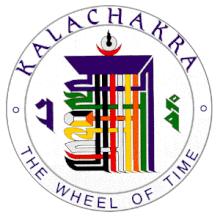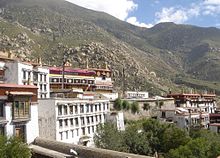Gelug
| Tibetan name |
|---|
|
Tibetan script :
དགེ་ ལུགས་ པ ། དགའ་ ལྡན་ ལུགས །
|
|
Wylie transliteration : dge lugs, dga 'ldan lugs
|
|
Pronunciation in IPA : [
geluk, gandɛ̃luk ]
|
|
Official transcription of the PRCh : Gêlug, Gandainlug
|
|
THDL transcription : Geluk, Gandenluk
|
|
Other spellings: Gelug
|
| Chinese name |
|
Traditional :
格魯派 、 黃 教
|
|
Simplified :
格鲁派 、 黄 教 、 格丹 派
|
|
Pinyin : Gélǔpài, Huángjiào, Gédān pài
|
The Gelug school (also: Ganden tradition) is the youngest of the four main schools ( Nyingma , Sakya , Kagyu and Gelug) of Tibetan Buddhism ( Vajrayana ). The followers of this school are called "Gelugpa" (Tib .: dge lugs pa ). The Gelug School was closer to pure Mahayana in its beginnings . The nominal head of the Gelug school is the " Ganden Thripa " (Tib .: dga 'ldan khri pa ).
Origin and teaching
Mahayana basics
The Gelug school is also known as the "school of the virtuous" and is based on the teaching of the great reformer Tsongkhapa (1357-1419). He represented the ideals of the Kadam School and emphasized the importance of the Vinaya rules . That is why the Gelug place great value on monastic discipline and celibacy . The core of the transmissions of the Gelug lies in the teachings of the Kadam school, especially in the Mahayana teachings of Atisha , which Tsongkhapa (1357-1419) received from teachers of the Sakya, Kagyu and Nyingma schools. The former Kadam school has not been preserved as an independent school. Tsongkhapa summarized the Mahayana teachings of the philosophers Nagarjuna , Asanga and Dignaga in his work Lam-rin chen-mo ("Great Exposition of the Gradual Path"). The “ Lamrim -Stepped Path to Enlightenment” is the basis of the path to enlightenment taught by the Gelugpa to this day.
Tantric teachings
The teachings of Kalachakra tantra are also of great importance in the Gelug school. Besides the practice on Yamantaka , Chakrasamvara and Guhyasamaja it is one of the main tantric transmissions of the Gelug. Over the centuries, however, various tantric teachings have also been adopted from the other secondary schools, including the “ Six Yogas of Naropa ”. Tsongkhapa had already written a fundamental commentary on these teachings, which is valued in all schools of Tibetan Buddhism due to the comprehensive treatment of the subject. Various other Mahamudra teachings from the Kagyu and Sakya schools, as well as various tantric teachings from the Nyingma, are passed on from the Gelug school. There are also isolated supporters of Dzogchen , probably since the time of the 5th Dalai Lama Ngawang Lobsang Gyatsho .
Important monasteries
In 1409, Tsongkhapa founded Ganden Monastery near Lhasa , which became his headquarters. Close disciples of Tsongkhapa founded the Drepung Monastery near Lhasa in 1416 and the Sera Monastery in 1419 , the Lower Tantra College (Gyumi) in 1440, the Upper Tantra College (Gyutö) in 1474 and in 1447 the Trashilhünpo Monastery in Samzhubzê , which later Headquarters of the Penchen Lama became.
Tsongkhapa himself never had political ambitions; he fled when he was about to be invited to China by an emissary of the Chinese emperor. Despite his clear rejection of politics and power, the three monasteries Ganden, Drepung and Sera later became the “three pillars of the state” after the Gelug took over political power in Tibet. Whether the later unification of “state and church” within the Gelug Order was always carried out for the benefit of the Tibetan people (and the other schools) is assessed differently by the supporters of the various schools. Power-political distortions, however, play a subordinate role in comparison with the excesses historically known from Europe.
Due to political tensions in Indian exile, two new large monasteries of the Gelug tradition were established in 2008 in Bylakuppe (Serpom Thösam Norling Datsang) and Mundgod (Shar Gaden Nampar Gyalwä Ling), both in the state of Karnataka.
Chief and Eminent Teacher
The head of the Gelug school is the "Ganden Thripa", who is elected by the monasteries and as the "Throne Holder of Ganden" symbolizes the succession of Tsongkhapa. The office of Ganden Thripa is not tied to the Trülku system, the term of office is seven years. The current 102nd Ganden Thripa is Thubten Nyima Lungtog Tendzin Norbu ( Rizong Rinpoche ).
The Dalai Lamas - the title was first awarded by Altan Khan in 1578 - and the Penchen Lamas, as well as the Khalkha Jetsün Dampa in Buddhism in Mongolia, are among the highest trulkus of the Gelug School .
Loden Sherab Dagyab lives in Germany , a high-ranking Gelugpa Lama who has worked at the University of Bonn since 1966 and has been giving Buddhist teachings and overseeing Buddhist centers since 1984.
Rime
In the 19th century, the masters Jamyang Khyentse Wangpo , Jamgön Kongtrül Lodrö Thaye and Orgyen Choggyur Lingpa created the " Rime movement ", which collected group-wide teachings from all areas of Tibet and from masters of all traditions, including competition (sectarianism) among the Tibetans Schools to prevent. Various Gelugpa lamas also joined this movement. The current Dalai Lama ( Tenzin Gyatso ), himself the holder of many transmissions from the other schools, repeatedly emphasizes the importance of a non-sectarian attitude towards all schools.
distribution
In addition to the Tibetan Mongolian cultural area, Gelug communities can also be found in America and Europe. One focus of the spread of this tradition in Europe is Switzerland, where many Tibetan refugees have settled, but there are also Gelug communities in Germany and Austria.
literature
- The Middle Step Path by Tsongkhapa, Diamond Publishing House, ISBN 3-9810682-3-8
- LS Dagyab Rinpoche: Mindfulness and Contemplation . Diederichs, Munich 2001, ISBN 3-7205-2264-4
- B. Alan Wallace: From Tibet to New York . Diamant Verlag, Arnstorf 1995, ISBN 3-924045-12-7
- Jonathan Landaw and Andy Weber: Images of Awakening . Diamant Verlag, Munich 1997, ISBN 3-9805798-1-6
- Alexander Berzin : Kalachakra - The Wheel of Time . OW Barth Verlag, Bern-Munich-Vienna 2002, ISBN 3-502-61068-1
- Dalai Lama: Dzogchen - The Heart Essence of Great Perfection . Theseus Verlag, Berlin 2001, ISBN 3-89620-171-9
- Dalai Lama: Introduction to Buddhism . Herder Verlag, Freiburg im Breisgau 2000, ISBN 3-451-04946-5
- Geshe Rabten: Mahamudra - The way to the knowledge of reality . Theseus Verlag Berlin, ISBN 3-89620-009-7
- Geshe Rabten: Essence of Wisdom - A Commentary on the Heart Sutra . dharma-edition, Hamburg 1990 ISBN 3-927862-06-1
- Geshe Wangyal: Tibetan Meditations . Theseus Verlag, Berlin, ISBN 3-89620-002-X
- Jamyang Khyentse Rinpoche: Opening of the Dharma . Library of Tibetan Works and Archives, Dharamsala 1974
- Karl-Heinz Golzio / Pietro Bandini: The fourteen rebirths of the Dalai Lama . OW Barth Verlag, Bern-Munich-Vienna 1997, ISBN 3-502-61002-9
Web links
- Douglas Duckworth: Entry in Edward N. Zalta (Ed.): Stanford Encyclopedia of Philosophy .
| Gelug (alternative names of the lemma) |
|---|
| Geden, dge ldan, Gedenpa, dge ldan pa, Shanju Gadan pai 山居 噶 丹 派, ri bo dga 'ldan pa, Gadan shan pai 噶 丹山 派, New Kadam School, Xin Gadang pai 新 噶当派 |

